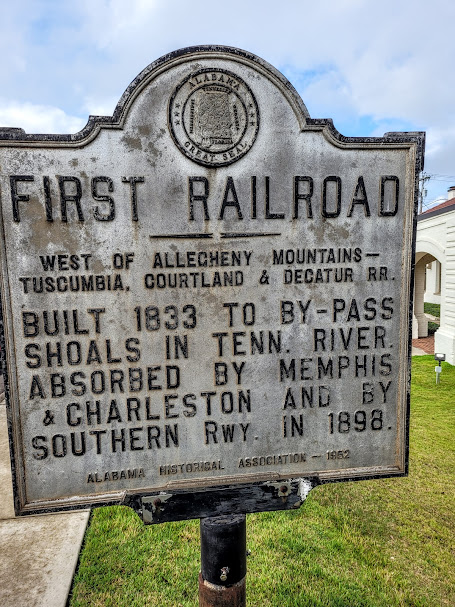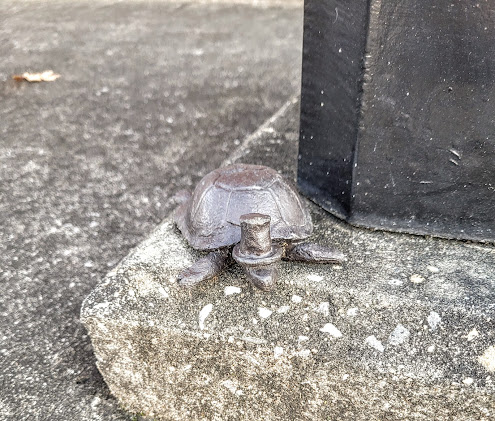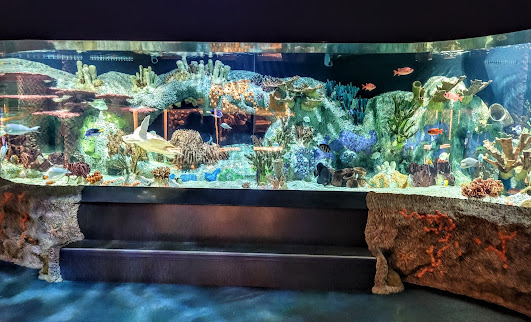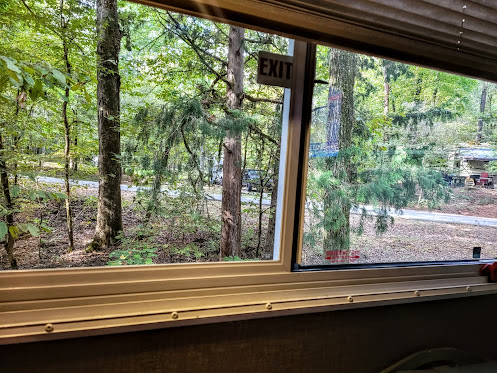Sure, that what the sign says... but what do they really mean.Alabama is proud of their participation in the U.S. space program. There are many opportunities to visit a variety of space related facilities.
Actually, their Visitor Center was very informative. Outside visitors can walk around a Saturn rocket and memorials to Alabama veterans.
Korean Memorial
Vietnam Memorial
Leaving the rest stop/Visitor Center, we made it to Decatur Elks for the week.
As you can see, the lounge has space for six rigs, electrical and water only. We were lucky to witness their annual indoor garage sale, which did pretty good, and the leftover items were donated. The only drawback was the trucking transportation company next door. Trucks were dropping off and picking up, all hours of the day and night. Some of the trailers were the refrigeration type, and would run during the night, they were loud too.Decatur, established in 1817, didn't start out Decatur, originally it was Rhodes Ferry Landing. It was named after Dr. Henry Rhodes who ran a ferry service across the Tennessee River. from 1830 to 1860, the town saw growth during these decades.
1862 changed things. During the war the town changed control eight times, it was strategic to the locations of two railroads, and the Tennessee river. By the time the war was over, Decatur only had four buildings standing. Some of the buildings left standing can be visited.
One of the buildings is the Bank of the State of Alabama, Decatur branch (Old State Bank).
The bank was erected in 1833, at a whopping cost of $9,482 dollars. The bank looks big, but the second story was a residence, for the Head Cashier, which was required by the banking laws of the time.
The upstairs was a modest home with two bedrooms, main social area, and a dining room. The kitchen was downstairs, outside. In the photos of the outside of the building, the second photo shows the cooking building (with the porch overhang). When the bank was operational, customers would enter the lobby and walk to an open window to conduct their business.
This bank was built using freedmen, and slaves. and by traditions of the times, the enslaved men were set free by their owner at the opening of the bank. From the pictures you can see that the normal way of heating the bank was by fireplaces located at each end of the lobby.The craftsmanship was high quality for the era. The columns at the front of the bank, were estimated to weigh near 100 tons each, and quarried from a plantation near the site. Inside the workmanship is just as phenomenal.
The first floor of the building required special locks and hinges; the hinges were hand made.Let's look at one of the important places of the bank... the vault.
The door to the vault was so heavy that a groove was created in the floor for the door to ride in.A little more for the history lovers, this vault was believed to have been the surgical suite for the Union forces. When the Union Army took control of the building, it was a private residence, the bank had closed for business in 1842.Two of the other buildings that withstood the Civil War, were personal residences, only because they were used as headquarters for the two forces.This is the Dancy-Polk House. The home was built in 1829. The original owner, Colonel William Francis Dancy, sold his home to a Mr. James Wood. Mr. Wood's had a daughter Lavinia, that married a man, Mr. Thomas Gilchrist Polk, a cousin to President James K. Polk. Lavinia and Thomas resided in the house with their three daughters. This home can be visited.
This next home, Rhea-McEntire house, It not certain when this home was actually built, but it is believed that Mr. Rhea started and completed the construction in 1836. Unfortunately in 1837 there was a financial panic, which stuck Mr. Rhea severely, forcing him to forfeit the house to the State Bank of Alabama in 1839.
All three of these structures, and the residents, witnessed a major injustice to the American Native Indian, The Trail of Tears. Thanks to President Andrew Jackson's Indian Removal Act of 1830, Native American Indians were forced to move from their homelands in the South, to reservations in Oklahoma. Roughly 2,300 Cherokee were moved through Decatur, loaded on railcars, or they were barged up the Tennessee River, to Oklahoma.
Before slaves were mistreated, and disrespected, there was the Native American Indian, and that would have been seen here in Decatur. When the weather had gotten bad, and a locomotive was not available to move carloads of Indians, they were housed in warehouses, used for storing predominantly cotton.The Native American Indians were left to figure out just how to hold up in the warehouses until the following morning, before shipment to Oklahoma. Initially the could not see, therefore did not settle in for the night. It wasn't until Dr. Lillybridge stepped in and spoke with railroad personnel, requesting lights for the overnight visitors. This is an exert from Dr. Lilybridges' journal regarding that night: "no one had made it their business to aid and direct the Indians, where they could lie for the night. It appears that no order or direction had been given in this particular, except that they would lodge in the warehouse... the Indians were afraid to lie down for fear of being run over. No lights were furnished them, and they were groping in the dark in a pitiful manner. The Physician (Lillybridge), at this time, took the responsibility upon himself, to request the R.R. Agent, to furnish lights, which was forthwith done. He also went round and directed where Indians could make their beds." Of the three parties of Indians passing through Decatur, only one party did not require housing for a night.
Our next stop was Morgan County Archives.
Visit: http://www.co.morgan.al.us/archivesindex.html.
The archive/museum is located in the old Tennessee Valley Bank building, built in 1927. Going on their website, visitors can see the exterior of the building and the vault.
Decatur became a shipping hub in its early years, because of the Tennessee River, and railroads.The problem with shipping via river... the rapids and shoals between Decatur and Tuscumbia. By river it made it to Decatur, then loaded on railcars to Tuscumbia, then back to riverboats.
What peaked my interest was a trail involving nine black boys, The Scottsboro Boys. This photo was taken before their second trial. But let's step back to the beginning. The beginning would be 1931, in the midst of depression. Like most folks during the depression era, these boys, aged 12 to 19, who did not know each other, hitched a ride on the rails, looking for jobs.
During the journey a scuffle broke out between the whites riding in the car, and the black boys. Railroad authorities were summoned at a railroad stop to squelch the altercation... with the black travelers being thrown off the train, and arrested. There was some confusion during their arrests, and they were accused of raping two of the white women hoboes in the train car.
This is where the nightmare begins. One of the women hoboes, who had been recently released from jail for adultery and fornication, was concerned about going back to jail for crossing state line to conduct illicit actions. Her decision was to cry rape, and convince the other woman to corroborate her story. News of the accusations traveled like wildfire through the county, with an angry mob heading to Scottsboro. The Sheriff had to deputize additional men to protect the accused from a lynching.
In less than two weeks eight boys were tried without proper legal representation, found guilty, and sentenced to death by electric chair. The prosecuting attorney in the trial of the 12 year old boy wanted "life in prison", but seven of the jurors wanted him to be executed. This young boy's trial ended in a hung jury. The trials were appealed up to the U.S. Supreme Court, the cases were to be re-tried.
Their trial was moved to Decatur. In Decatur, Judge James Horton would preside over the trial, a fair-minded jurist against mob thinking, and mob violence. Two years elapsed between the first and second trials. During the appeals process the defendants were housed on Death Row.
A break before the trial so you can get mentally prepared. Ya see, ya may be one of the jurors for this case, or ya might be someone testifying.If you are one of the selected jurors, this would have been your observation perch for the trial. on the other hand:This was home for all those that had to testify... for, or against, the boys. There is a story that goes with the witness stand. The platform was found in the county at someone's trailer... they were the steps up to the door.
State and local officials were aware that Alabama's reputation had been drug through the mud because of the first trial. With a multitude of locals, outsiders, and press, the National Guard were brought in for crowd control.
The Attorney General Thomas knight, was a real piece of work. His plan was to ride the backs of the defendants to the Governors Office. This guy even doubted the credibility of the two accusers, considering them "women of a very low type". He was so confident that he would again convict the defendants. His plan was: dehumanize black witnesses that came to court, play on juror's fear of Communism (defense was payed for by the legal arm of the American Communist Party), creating a bias against the Northern legal representation, the lack of black jurors, and exploit the white Southerner's fear of black men raping white women, when given the opportunity.
Thomas Knight was incredulous about the defense's questioning the integrity the jury pool, and the judgements of the court officials, regarding exclusion of blacks on juries.
The prosecutor, Thomas Knight, used witnesses testifying with stories that were impossible. A good example was Orby Dobbins. This guy testified that he saw the rape, from his barn loft, as the train was passing by; the defense proved that it was an impossibility.
Let's talk the defense, Samuel Leibowitz, Joseph Brodsky, and George Chamlee. George Chamlee, a Southern lawyer was the one that successfully argued their case before the U.S. Supreme Court, for the re-trial. He was the type of lawyer the defended communists, and other radicals.
The first move of the defense was a motion to quash the indictment based on the constant refusal to allow blacks to sit on the jury. The motion changed future jury pools in America.
Their next move, unusual for the era... question witnesses, using forensics. They also focused on Victoria Price's history of prostitution; they had Lionel Company create an exact replica of the train. The replica train is on display at Cornell University.
Remember Ruby Bates... the second woman? After the first Scottsboro trial, the state dropped her as a witness. The defense team found her, and she testified in the second trial that the story was fabricated.
Dr. Bridges testified that there was no evidence of rape regarding Victoria, of Ruby.
With all the great defense evidence, the jury was swayed by the prosecutors tactics, pronounced Haywood Peterson and the rest of the boys... guilty. Judge Horton was appalled, because he heard the same evidence as the jury. His conscience did not allow him to sentence the boys to death, instead he set aside the verdict and ordered a new trial.
Over the next six years, all kinds of things happened, including Alabama Supreme Court removing the cases from Judge Horton's court. The new judge, Judge William Callahan, made every effort to hurry the cases along to a guilty verdict. The Alabama system finally was wore down, and dropped the charges on four of the boys and reduced sentence on the other boys. The boys were scarred for life.
Thanks to the people that stood up for justice, our judicial system made great strides to ensure equality.
Moving on. This will only be a few photos of the items on display pertaining to the Civil War. There was a lot more to see, but you will have to visit to see it all. From the Archives we moved over to the train station.One side of the re-vamped building is the museum, the other side is the Police Station annex. This building is a third generation building, the others were built closer to the Tennessee River. The Tuscumbia, Courtland & Decatur Railroad had more history than just moving product around the rapids and shoals of the river, it carried the 2,300 Cherokee along the Trail of Tears.
Segregation was evident at the train station, whites received service on one side, blacks on the other.What is so important about this window you ask... evidence of segregation. The ticket window I am shooting the picture through, is on the white passenger side. Look closer to the other window in the photo, that was where the black passengers got their tickets. As you can see, whites thought that black folks could not be trusted, and it was necessary to put bars on the window. The Police annex is located on that side of the building, obviously there is no opportunity to visit the other side.
While in Decatur we had dinner with some friends we hadn't seen in many years.
Before we sat down for dinner, Carol and I took on the Turtle Trail, in downtown Decatur. The walk is like a scavenger hunt. The hunt can be easily completed with the assistance of provided clues on a handout from the Information Center in town. The walk is a little over a mile and half, looking for 10 little turtles, on Main Street.Each one of the turtles has a short story connected to them, and I am only going to show you six, you will have to go to Decatur to find the rest.
The next day we made a journey to the Cook Museum of Natural Science (https://www.cookmuseum.org).The original museum was a small museum created by the owner of a pest control business.
The first stop was at a wall that showed evidence of natural laws. The first panel explained the Fibonacci Sequence, which nature uses for creating spirals. Another panels explained nature's use of branching and dividing, to create patterns.
This museum actually maintains a colony oy bees.A colony can average 50,000 bees during its peak, usually late spring to early summer.There are a lot of bees in the colony for a reason, most worker bees will only make 1/12th of a teaspoon of honey in their lifetime. To get to that much, or little of honey, the worker bee needs to visit 50 to 100 flowers a day. 15,000 bees can made one pound of honey, making a trip, no greater than six miles. Think of yourself as a bee making that trip, flapping your wings about 190 times per second, knowing your best speed will be 15 MPH. That much work for a small payoff, lends to a short lifespan. The bee colony works pretty hard, that includes the guys that keep the colony clean, which means getting rid of their dead counterparts. In the case of this colony, there is a tube in the back wall that goes out to the outside world, where they dispose of the dead coworker.
They have an astronomy exhibit that id interactive. One of the interactions is an opportunity to blow up earth. Another was changing the magnetic field of the earth, via solar flares, and seeing how it effects the earth.
From astronomy, we moved onto rocks, beautiful rocks.
I hope you have your waders on, the next section was a wet one.
I guess I never really paid attention to duck anatomy, because they are broken into two groups: divers, and dabblers.The diving group are built with large feet, attached to legs that are located to the rear of their bodies, helping them through the water; they also push air out of their feathers before diving.
Dabblers are built with their legs more to center of the body. These guys operate by sticking their heads under water, straining plants and invertebrates. Because of the location of their legs, they are capable of hunting on land.
I love mussels, but they're sneaky creatures, and visitors can read it here.You can have your choice of Pimplebacks, Heelsplitters, and Pigtoes. If those don't suit ya, try one of the other 175+ freshwater varieties living in Alabama.
These little guys are hard workers, just one mussel can filter two gallons of water in an hour. With a river bottom covered with mussels, the water will be cleaner, and one way to know it is when 300+ mussels in a square yard of river bottom.
Now I bet you're asking yourself... how does their population grow? Remember I said these creatures are sneaky, this is how. The mussel airs out an egg sac, the fish bites into the sac, the parasite larvae explode in the mouth and gills. When the larvae mature, they drop from the gills, into new territory. Enough grow, and I now have mussels for dinner.
The next section allowed the opportunity to go fishing.The sea turtle in the tank is a rescued turtle. He is home because of a pinhole opening in his throat, so there was a concern he might choke on the food he was eating, so he is monitored here at the museum... for life.
On our way into the next exhibit was a display demonstrating the weight of a hummingbird:Think, the next time you have a penny in your hand, you know the weight of a hummingbird.
Past the hummingbird was lots of bugs and butterflies.The bugs were the last exhibit in the museum before leaving... besides the gift shop of course.
The last stop was the U.S. Veteran Memorial Museum, in Huntsville, (https://www.memorialmuseum.org), which honors the service of those men and women that served in our countries militaries.
This museum is full of stories and equipment. The equipment ranges from personnel carriers to helicopters. There is a long wall memorializing all the Medal of Honor recipients.
How many of you out there know that France sent the United States a huge gift after WWII? they did, in the form of railcars.These railcars were used during WWI and WWII, to transport troops and horses. The cars were call "40-8s", because they carried either 40 soldiers, or 8 horses. Anyway, back to the gifts from France. In 1949 France shipped over 49 of these railcars, one for each state, full of gifts, to show their appreciation for all the efforts our American soldiers did for them during WWI and WWII.
This museum had the best exhibit of military uniforms I have seen so far.This museum has everything for the war of your choice, all the way to Afghanistan.
From here we head further south, so we will see you later.
Here we are at our next stop in Alabama, Deerlick Campground, a Corp of Engineering recreation area, outside of Tuscaloosa. This last picture is looking out the window by my chair... how peaceful. We only stayed a few days before we headed off to Mississippi. We did stop in for a little seafood tasting.It was good, for a franchise restaurant throughout the South. We had never seen the boil served in plastic bags.
Off to Mississippi.

















































































No comments:
Post a Comment